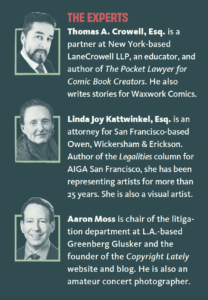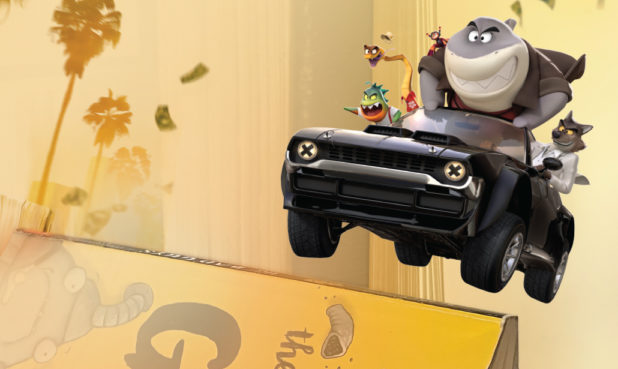
Getting started
Copyright protections give authors and artists control over how their work is used. While you cannot attain a copyright for ideas, titles, and concepts, you can for any specific creative expression that you have put in tangible form. All our experts stress from the start that any artist who creates work they believe has value would be shrewd to familiarize themselves with basic copyright concepts.
“It’s important,” says Kattwinkel, “because if you’re not aware of how copyright law works in this country, you can lose control of your work really easily, and other people can take it and do what they want with it … whether or not they give you credit or pay you for it.”
Why you should register for copyright protection:
According to U.S. law, any person who creates something “fixed in any tangible medium of expression” automatically has copyright protection for that work. But registering it officially with the U.S. Copyright Office is an essential, cost-effective way to protect your work because it gives you added legal leverage.
“If you think your screenplay or your art is worth the cost, get a copyright registration straight away,” says Moss. Depending on the type of material being registered, basic fees can range from $45-$125.
Start the process now and then be patient:
Apply for your copyright registration early—and wait until you have it before making your work public. This is a tough one to swallow, but the risks are too great. As a result of the 2019 Supreme Court decision in Fourth Estate Pub. Benefit Corp. v. Wall-Street.com, LLC, copyright holders must have their U.S. Copyright Office-issued registration certificate in hand before they can file a suit for copyright infringement.
Kattwinkel says that clients often disregard this advice because they don’t want to wait months for the U.S. Copyright Office to process the application. “The minute you put something online, it’s vulnerable to illicit copying,” she warns. “And it’s vulnerable worldwide. Without a registration you have no bargaining power when you tell someone to stop infringing. If they know you can’t take them to court, they can ignore you.”
Best Practice Tips
- Some online services—with URLs suspiciously close to the official copyright.gov—offer to register your copyrights for you for a premium. Don’t use them. Do it yourself. It’s simple.
- While registering your screenplay with the Writers Guild documents authorship from a given date, it does not guarantee legal protection, so make sure to register with the U.S. Copyright Office.
- Register your copyrights annually. One efficient approach is to put all your creative output for the year in a print or digital sketchbook and then register the entire book as a single work.
What you should know before you pitch original work
When you’ve created something specific to pitch a client that they may want to adopt, buy, or license from you, it’s not always easy to protect. Generally, the same legal concepts apply to literary and graphic works, but the hard truth is that it is much easier to find similarities in written works and thus much harder to protect them. Common elements are inevitable, and if broad ideas without detailed plot and characters—even if they’re unique—just aren’t protectable, pitching them without a contract exposes them to potential theft without recourse. “That’s a bitter pill to swallow for a lot of artists,” says Crowell. “The best way to protect yourself is to put your idea—your concept as fully as you can, either in a sketchbook or in a screenplay—and then register copyright to that work.”
Animation and visual artists naturally have greater protections because they’re presenting copyrightable expression, so infringements are easier to spot. Still, gray areas are legion. Your two greatest defenses are nondisclosure agreements and being sure to work only with credible people. Regarding NDAs, though, the big studios and networks will first require you to sign away your right to sue in exchange for allowing you to pitch, since it’s possible that they’re already working on something with similarity to your work. The thing you can control is being sure to pitch to only reputable people. “Anybody at any sort of high level … they’re relying on their reputation,” says Moss, “the reputation of the people they’re surrounding themselves with, and the copyright law, but nothing else.”
Best Practice Tips
- “If you have something that you think is particularly unique and valuable, keep it close to your vest until you’re in a position to find people who can actually help you bring it to market,” says Moss. “At the end of the day, there’s only so much you can do if people are sketchy.”
- Don’t leave high-resolution digital copies with anybody, and don’t post beautiful high-res images online, because they are easily copyable and repurposed. Post low-res images, which at least won’t work for offline purposes.
“Most of where the tension arises is how do you draw the line between allowing something that is going to be good for your brand because you’re encouraging really interested fans to surround themselves with your IP versus [something that crosses] into a commercial area.”
Creating fan art
It’s important to state outright two key points. 1) It is illegal to use someone’s copyrighted work in any way without their permission (unless it falls under fair use exceptions, see sidebar). 2) A copyright holder can bring a suit against anyone who’s infringed on their copyright no matter how small the profits of the violator—even zero. That said, there are lots of reasons why copyright holders may allow, and even encourage, derivative works, or refrain from bringing down the legal hammer when their IP is used in others’ artwork.
For one thing, many aspiring artists draw from well-known existing characters to hone their chops, showcase their talent, and fill out their portfolio as an enticement to fans of the original work and potential employers. Some companies even require this, and there are plenty of examples of artists hired by these companies based on that derivative work. In addition, some artists may sanction the use of their IP to increase exposure to their characters and brand. But if your unlicensed art is successful enough that you are making bank, that copyright holder is going to come after you.
“Most of where the tension arises—and this is something that big media companies face all the time—is how do you draw the line between allowing something that is going to be good for your brand because you’re encouraging really interested fans to surround themselves with your IP versus [something that crosses] into a commercial area,” says Moss.
So yes, you can make unlicensed fan art, and even try to sell it. Some of it may even fall under fair use. For example, one-off works of fine art that utilize well-known characters in a new context have a better fair use argument than mass-produced T-shirts with well-known IP that is protected by both copyright and trademark. In the latter case, a company like DC or Warner Bros. could easily make you destroy all your product and pay damages.
Best Practice Tip
- Often creators who start from a place of wanting fans to have unobstructed access to their creative universe end up backpedaling once whole cottage industries of derivative work spring up on Etsy, eBay, and YouTube. While there’s no magic language to prevent this, and it doesn’t have the legal standing copyright registration does, Moss suggests placing a statement on whichever platforms showcase your work saying, “With regard to fan art and fan fiction, our policy is that we encourage our fan community to create derivative works that feature our IP for noncommercial purposes. However, this permission does not extend to using the IP for any sort of commercial purposes or monetization.”
“The court rewards creators for taking art, even if it’s without permission, and transforming it, recasting it, putting it in a context that was not the original context. The more you’re doing that, the more likely that it will be seen as fair use. When in doubt: transform.”
Works made for hire
Professional relationships that involve works made for hire fall into two categories, and who owns the copyright on the resulting work can vary depending on the context of the relationship.
Employer-Employee
This dynamic is seemingly straightforward: If the work you create is done as part of the scope of your employment, then your employer automatically owns it. In fact, the law treats that copyrighted material as if it were created by the employer, meaning the company does not even need to name or acknowledge your part in creating it.
That said, pay very close attention to the precise contours of the scope of your employment agreement to determine whether anything you create falls outside of it and thus belongs to you as an individual artist. “For example,” says Moss, “if you have been hired to come up with ideas for new animated characters, the company has a pretty good argument that any character idea you come up with while employed will be owned by the company”—especially if you do it on company time or using company equipment, supplies, or facilities.
If you are hired to work specifically on the company’s preexisting properties, however, and not to develop new characters or properties, then the employer will likely not have any claim to any new characters you create on your own time. Keep in mind that there are nuances to all of this. In essence, the broader the scope of your employment, the more cautious you should be.
Independent Contractor
If an author or artist is hired to create something on a freelance basis, who owns the copyright depends on whether there has been an express written agreement commissioning the work as made for hire and that this work falls into one of nine statutory categories. With a valid contract of that type in place, the hiring party is considered the author and copyright holder of the work; without it, the creator retains copyright. There are nuances to this depending on whether the work was based on the hiring party’s IP and what either party does with the work afterward.
Best Practice Tips
- It’s best to avoid using company equipment on the sly. This is one of the factors a court might review to determine whether an employee has a right to a creation.
- Freelancers hired in California have an additional negotiating tool in that state law requires the hiring party to treat an independent contractor in a work made for hire situation as an employee and not a freelancer. If you want to retain copyright, you could try using this to pressure the hiring party to forego the work for hire agreement.
- Depending on the type of project, when facing a work for hire demand from a potential client, consider making the fee for your work commensurate with the potential loss of copyright. Offer a choice between a full buy-out cost and a lower fee that includes an exclusive license for just a few years after which you regain copyright.
Taking action against infringement
If you believe your copyrighted work has been infringed upon and you want to act on it, your main options are a takedown notice, a cease-and-desist letter, and a lawsuit. “But you really have to think about not just your legal rights but how it looks in the court of public opinion,” says Moss. “What’s the PR backlash going to be? You want to make sure that you’re doing a cost-benefit analysis and seeing the big picture, because if you’re just starting out and you’ve got a burgeoning fanbase, you want to have those soldiers helping to spread the word for you.”
Best Practice Tips
- If you decide to send a cease-and-desist letter, keep in mind that it can be immediately posted online. Use tempered, appreciative language that acknowledges the fan’s love of your IP while stressing that monetizing it in this way dilutes your copyrights and trademarks. “You’re just trying to make these people understand that there are two sides of this, and usually that works,” says Moss.
- For cease-and-desist letters, it’s unwise to use a template you find online. These letters are most effective when they are tailored to the specific facts and laws at issue, so legal counsel is recommended. (See resources for volunteer arts attorneys.)
- If your infringed material is posted on a third-party-uploaded platform, take advantage of the DMCA’s Notice-and-Takedown System, which allows you to compel companies such as YouTube or Etsy to remove or block access to the disputed material quickly. This way you avoid direct contact with the offender and don’t risk coming off as aggressive or heavy-handed. Even better, you do not need a copyright registration to engage the DMCA takedown process.
Resources
The Pocket Lawyer for Comic Book Creators
by Thomas A. Crowell
Linda Joy Kattwinkel, Esq.’s Legalities column
This article is for informational purposes only and does not constitute legal advice.



